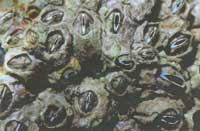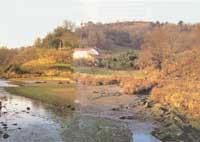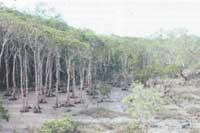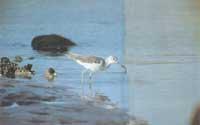Estuarine habitats and communities
Pelagic habitats and communities
The habitats and communities of the water column are mainly characterized by their salinity. Therefore, at the top of the estuary can appear river habitats and at the bottom marine habitat, but as fresh and saltwater are mixed, brackish or specifically estuarine habitats will be established.

In the oligohaline habitat (0.5-5‰) the smaller particles and colloids transported by the river water float, increasing the turbidity of the water. Therefore, although the concentration of inorganic foods in the oligohaline range is very high, the production of phytoplankton (plankton algae) is limited by the lack of light. However, the presence of organic substances from river waters allows an important heterotrophic community. Therefore, zooplankton (planktonic animals) is abundant, but the diversity of species is reduced, predominating in the estuaries of the northern hemisphere copepods of the genus Eurytemora.
In Mesohaline (5-18‰) and polyhaline (18-30‰) habitats, as the percentage of marine water is higher, the concentration and turbidity of the particles is lower. Therefore, in the mesohaline interval, by maintaining the concentration of nutrients at high level and increasing the light availability, the maximum development of phytoplanktonic algae is usually given. In the medium salinity community corresponding to these habitats, phytoplankton is composed mainly of diatoms, dinoflagellates and nanoflagellates. Among planktonic animals predominate copepods (mainly of the genus Acartia) and larvae of some benthic species (molluscs, polychaetes, etc. ).
The euhaline habitat (30‰) is more like the marine habitat, with ever lower concentrations of dissolved and particulate foods. The development of phytoplankton in euhaline waters is decreasing. Zooplankton biomass is lower, but diversity is much higher, as it is the area to which most marine groups and species spread. Marine copepods of the genus Calanus, Paracalanus, Acartia, Temora and Oithona, among others, cladoceros, apendiculariaceae, ketognatos, jellyfish and sifonoforos.
Benthic habitats and communities
In the benthic zone, soft substrate habitats are characterized by the size, exposure and salinity of sediment particles. In general, the habitats of the outer sandy substratum are unstable and well oxygenated. In these substrates, the development of microfitobentous (unicellular algae) is low and organic residues do not accumulate due to high current.
The biotic community, therefore, consists of heterotrophs and filtering and mobile organisms. Diversity is usually high, but biomass is low. Small crustaceans, especially amphipods, polychaetes such as Nephtys cirrosa and crab hermits such as Pagurus spp, stand out.

In deep muddy substrates the production of microfitobentous is limited by light and under the surface of the sediment the area becomes anomalous due to the decomposition of the accumulated organic matter. In this situation, animal density and biomass are small, with most sedimentary species. In this habitat stand out the bivalve (Abra alba for example), the policeto and the perforating sea urchins ( Echinocardium cordatum) inside the sediment, while on the surface stand out the starfish Ophiura and the gastronopod Philine.
The intertidal plain and the habitats of the subtidal surface substratum are mainly developed in estuaries and bar-estuaries of the coastal plain. In these areas the biological production is very high, especially if they are muddy. Microalgae production and consumer biomass (meiofauna and macrofauna) are high, although species diversity is not high. In the community of muddy sand the most important organisms are some policetos and bivalvos like cerastoderma edule or berberberecho. In the communities of muddy sand of variable salinity predominates the estuarine worm Arenicola marina, other species of polychaetes, bivalves ( Cerastoderma, Macoma) and gastropods ( Hydrobia ulvae) also abound in the intertidal zone.
In the communities of variable and/or low salinity mud, the bivalves ( Scrobicularia plana) are limited to the intertidal zones, predominating the polychaetes ( Hedistes diversicolor). At the limit of marine influence, the community of low-salinity sludge is formed by oligochets and tube-worms inside the sediment and on the intertidal surface one can often observe the cover of blue-green algae (cyanophies) and diatoms. To this area of very low salinity you can add some freshwater invertebrates.

Sometimes, in the outer soft sediments an important community of superficial macroalgae is established, mainly composed of large algae Sargassum muticum invasive of Laminaria, Chorda or European estuaries. The development of Zostera sea grass pastures in estuaries is also common: Z. marina in areas of high salinity and Z. noltii and Z. angustifolia in areas of lower salinity.
Species distribution of hard substrate or rock habitats is limited by salinity and exposure and, in general, by their importance in rías, fjords and fjords. The most common inhabitants of the outside community are gasteropods ( Littorina spp) and cirripeds ( Chthamalus spp) on the intertidal top, mussels ( Mytilus spp) and lapas ( Patella spp) on the center and red algae ( Corallinacea) on the lower.
Brown algae (Fucus, Ascophyllum and Laminaria) also abound in the middle and lower areas of these areas. In the community of variable salinity the diversity of species is reduced and the importance of some brown algae such as Ascophyllum and Fucus is appreciated. Among the typical species of these communities. there are several cirripeds ( Semibalanus and Elminius), briozoa, amphibians and green algae ( Enteromorpha spp). Although the presence of brown algae in the community of low salinity (Fucus vesiculosus and F. ceranoides mainly) is evident, in the upper part predominate the green algae Blindigia and Rhizoclonium. In the region of very low salinity it is not possible to implement most species of marine origin, since it reduces salinity and the surface appears colonized by cyaniofyceans and firm diatoms.
Environment systems
In relation to water level rises, in the vicinity of estuaries are unique wetlands such as marshes in temperate latitudes and mangroves in the tropics.

The marshes, like the estuaries, are young communities, since most of today began to appear about 3 thousand years ago due to the last increase in sea level. They are mainly developed in areas of mud protected from waves. In macromareales estuaries large marshes appear and in small micromareales appearances. In these systems the most widespread grammar is that of the genus Spartina, being the usual ones of the genera Salicornia, Halimione, Juncus and Plantago. In the upper areas of the estuary and in the transition to the fresh waters, the Marismeña community consists of Typha, Scirpus, Cyperus and Phragmites, instead of these species.
The Mangladi community consists of shrubs and/or halophytic trees of 12 genera, which resembles the rainforest. Because the roots of these plants are in the saline and anaerobic substratum, they have developed specific morphological, anatomical and physiological adaptations that, in addition to reducing the harmful effect of salt, allow obtaining the necessary oxygen for the breath of the roots. Linked to vegetation, there is a fauna with a great wealth of species; the greatest specific diversity has been observed in the mangroves of South Asia.
In these two communities exposed to the tide, primary production is very high, but most of the biomass produced by plants is not consumed by herbivores and remains for the use of detritories and decomposers. In addition, much of the detritus generated in marshes or mangroves are transported by tides to other places where they become the basis of detrital food chains.
Superior consumers in estuaries: fish and birds

Open sea fish do not need too much bottom, but in estuaries there are few species of fish totally independent of the bottom. Most species live near the bottom or on the substrate, although sometimes they may appear in the water column.
Estuarine fish are usually classified into four groups. The largest group is marine migrants. These species live and fertilize in the sea, but the estuary is very appropriate for young people as a breeding place. The number of species in this group is increasing from high latitudes to tropics; the best known are salmonetes ( Mullus sp), anchovies ( Engraulis sp), flat fish and lengorados ( Soleidae).
Fish anadromo, salmon ( Psalm), sturgeon ( Acipenser), coding ( Alosa) and lanproie ( Petromyzontidae) migrate from the sea through the rías for later reproduction in fresh water. These species are very important in the cold estuaries of the north. The fish catalogues are scarcer and the best known are the eels ( Anguilla spp). These, after reproducing in depth, return to the rivers. The egoiles of the estuary, that is, the species that give their entire life cycle in the estuary, generally have a small size and a low value for the human economy, but very important in the trophic network of the estuary. Among this group stand out the zarbos (gobiidae), the hazelnuts (atheriniidae) and some clupeidos.

Birds are also effective consumers in estuaries, especially in high and middle latitude estuaries. In them, in addition to the perennial populations (seagulls, cormorants, some ducks and marsh hens), migratory species can appear (scorched birds, geese and some ducks), which generates a rich and changing bird community throughout the year.
When sorting estuarine birds, food, eating habits, and tidal food activity are often used as criteria. In the group of birds crossed are those that feed on fish, crabs and small gastropods such as herons, egrets and ibis. Marginal birds (slide and chorlitejos, kurlintas, pedriscos, etc.) feed mainly on small shells and worms, and marine jellyfish of bivalves.
In general, all of them obtain food in flat intertidal zones and superficial substrates in low tide. Although fishing birds (cormorants, charranes, swallows, etc.) they feed on fish, they also capture large pelagic shells that consume a lot of different food, including trash. For ducks, plants are the main nutrient, but small benthic animals do not despise them when completing their diet. In the community of birds of the marsh, some species are rooted and fry, but most of them, like the hens of the marsh, feed on gastropods, shells and insects of the substratum.





